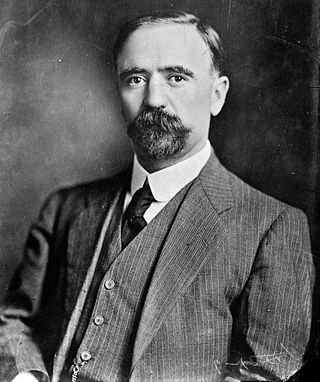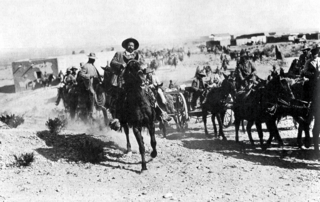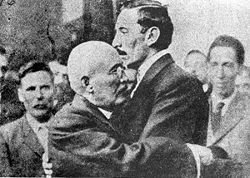
Francisco Ignacio Madero González was a Mexican businessman, revolutionary, writer and statesman, who served as the 37th president of Mexico from 1911 until he was deposed in a coup d'état in February 1913 and assassinated. He came to prominence as an advocate for democracy and as an opponent of President and de facto dictator Porfirio Díaz. After Díaz claimed to have won the fraudulent election of 1910 despite promising a return to democracy, Madero started the Mexican Revolution to oust Díaz. The Mexican revolution would continue until 1920, well after Madero and Díaz's deaths, with hundreds of thousands dead.

Francisco "Pancho" Villa was a Mexican revolutionary and prominent figure in the Mexican Revolution. He was a key figure in the revolutionary movement that forced out President Porfirio Díaz and brought Francisco I. Madero to power in 1911. When Madero was ousted by a coup led by General Victoriano Huerta in February 1913, Villa joined the anti-Huerta forces in the Constitutionalist Army led by Venustiano Carranza. After the defeat and exile of Huerta in July 1914, Villa broke with Carranza. Villa dominated the meeting of revolutionary generals that excluded Carranza and helped create a coalition government. Emiliano Zapata and Villa became formal allies in this period. Like Zapata, Villa was strongly in favor of land reform, but did not implement it when he had power.

José Victoriano Huerta Márquez was a general in the Mexican Federal Army and 39th President of Mexico, who came to power by coup against the democratically elected government of Francisco I. Madero with the aid of other Mexican generals and the U.S. Ambassador to Mexico. His violent seizure of power set off a new wave of armed conflict in the Mexican Revolution.

Pascual Orozco Vázquez, Jr. was a Mexican revolutionary leader who rose up to support Francisco I. Madero in late 1910 to depose long-time president Porfirio Díaz. Orozco was a natural military leader whose victory over the Federal Army at Ciudad Juárez was a key factor in forcing Díaz to resign in May 1911. Following Díaz's resignation and the democratic election of Madero in November 1911, Orozco served Madero as leader of the state militia in Chihuahua, a paltry reward for his service in the Mexican Revolution. Orozco revolted against the Madero government 16 months later, issuing the Plan Orozquista in March 1912. It was a serious revolt which the Federal Army struggled to suppress. When Victoriano Huerta led a coup d'état against Madero in February 1913 during which Madero was murdered, Orozco joined the Huerta regime. Orozco's revolt against Madero somewhat tarnished his revolutionary reputation, but his subsequent support of Huerta compounded the repugnance against him.

The Federal Army, also known as the Federales in popular culture, was the army of Mexico from 1876 to 1914 during the Porfiriato, the rule of President Porfirio Díaz, and during the presidencies of Francisco I. Madero and Victoriano Huerta. Under President Díaz, a military hero against the French Intervention in Mexico, the Federal Army was composed of senior officers who had served in long ago conflicts. At the time of the outbreak of the Mexican Revolution most were old men and incapable of leading men on the battlefield. When the rebellions broke out against Díaz following fraudulent elections of 1910, the Federal Army was incapable of responding.

The First Battle of Rellano was an engagement on 24 March 1912 during the Mexican Revolution at the Rellano railroad station, in the state of Chihuahua. It was fought between government troops loyal to Francisco I. Madero, led by General José González Salas, and rebel troops under Pascual Orozco. The battle was a victory for Orozco.

The División del Norte was an armed faction formed by Francisco I. Madero and initially led by General José González Salas following Madero's call to arms at the outbreak of the Mexican Revolution in 1910. González Salas served in Francisco I. Madero's cabinet as Minister of War, but at the outbreak of the 1912 rebellion by Pascual Orozco, González Salas organized 6,000 troops of the Federal Army at Torreón. Orozquista forces surprised González Salas at the First Battle of Rellano. They sent an explosives packed train hurtling toward the Federales, killing at least 60 and injuring González Salas. Mutinous troops killed one of his commanders and after seeing the officer's body, González Salas committed suicide.

José Inés Salazar was a Mexican revolutionary general who led the Orozquistas during the Mexican Revolution and later fought with Pancho Villa. He was a native of Casas Grandes, Chihuahua.

The Battle of Zacatecas, also known as the Toma de Zacatecas, was the bloodiest battle in the campaign to overthrow Mexican President Victoriano Huerta. On June 23, 1914, Pancho Villa's División del Norte decisively defeated the federal troops of General Luis Medina Barrón defending the town of Zacatecas. The great victory demoralized Huerta's supporters, leading to his resignation on July 15. However, the Toma de Zacatecas also marked the end of support of Villa's Division of the North from Constitutionalist leader Venustiano Carranza and US President Woodrow Wilson.

The Treaty of Ciudad Juárez was a peace treaty signed between the President of Mexico, Porfirio Díaz, and the revolutionary Francisco Madero on May 21, 1911. The treaty put an end to the fighting between forces supporting Madero and those of Díaz and thus concluded the initial phase of the Mexican Revolution.

The Battle of Cuautla was a battle between the forces of Emiliano Zapata and the federal army of the Mexican government that took place in the state of Morelos from May 11–19, 1911, during the Mexican Revolution. It has sometimes been described as "six of the most terrible days of battle in the whole Revolution". Eventually, the remains of the defending "Golden Fifth" regiment, the Fifth Cavalry Regiment of the Federal Army, withdrew and Zapata took control of the town. The Zapatista victory convinced Porfirio Díaz to come to terms with Francisco Madero, agree to the Treaty of Ciudad Juárez and resign as president.

Pablo González Garza was a general during the Mexican Revolution. He is considered to be the main organizer of the assassination of Emiliano Zapata.

The First Battle of Ciudad Juárez took place in April and May 1911 between federal forces loyal to President Porfirio Díaz and rebel forces of Francisco Madero, during the Mexican Revolution. Pascual Orozco and Pancho Villa commanded Madero's army, which besieged Ciudad Juárez, Chihuahua. After two days of fighting the city's garrison surrendered and Orozco and Villa took control of the town. The fall of Ciudad Juárez to Madero, combined with Emiliano Zapata's taking of Cuautla in Morelos, convinced Díaz that he could not hope to defeat the rebels. As a result, he agreed to the Treaty of Ciudad Juárez, resigned and went into exile in France, thus ending the initial stage of the Mexican Revolution.

General Jacinto Blas Treviño González was a Mexican military officer, noteworthy for his participation in the Mexican Revolution of 1910 to 1921.
Rellano is a railroad station in the south of the Mexican state of Chihuahua. It is located in the southern portion of the Bolsón de Mapimí river basin. During the Mexican Revolution it was the site of two major battles during Pascual Orozco's rebellion; the First Battle of Rellano and the Second Battle of Rellano.

The Mexican Border War, also known as the Border Campaign, refers to a series of military engagements which took place between the United States military and several Mexican factions in the Mexican–American border region of North America during the Mexican Revolution. It was the last major conflict fought on U.S. soil.

Emil Lugwig "Lewis" Holmdahl was an American soldier of fortune, infantryman, machine gunner, spy, gun runner, and treasure hunter who fought under Frederick Funston and John J. Pershing in the Spanish–American War and subsequent Philippine–American War, under Lee Christmas in Central America, under Francisco Madero, Pancho Villa, and Venustiano Carranza in the Mexican Revolution, and under John J. Pershing again in World War I. In 1926, Holmdahl was accused of having stolen Francisco "Pancho" Villa's head.
The Second Battle of Ciudad Juárez, also known as the Capture of Ciudad Juárez or “Villa’s Trojan Train” was a decisive rebel victory over the forces of Mexican president Victoriano Huerta. The federal garrison of the border city of Juárez was tricked into allowing 2,000 revolutionaries to enter the city on board a hijacked coal train. The revolutionaries crept out of the train under the cover of darkness and easily overcame the federal forces with a surprise attack.

The Battle of Ojinaga, also known as the Taking of Ojinaga, was one of the battles of the Mexican Revolution and was fought on January 11, 1914. The conflict put an end to the last stronghold of the Federal Army in Northern Mexico.

Raúl Miguel Hidalgo Madero González was a prominent Mexican revolutionary military and politician, brother of the hero of the Mexican Revolution. He was the brother of Francisco I. Madero and businessman and politician Gustavo A. Madero.


















